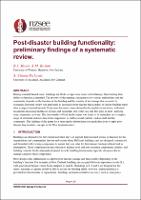| dc.contributor.author | Mayer, Bethany | |
| dc.contributor.author | Boston, Megan | |
| dc.contributor.author | Chang-Richards, Alice | |
| dc.date.accessioned | 2023-08-28T04:23:20Z | |
| dc.date.available | 2023-08-28T04:23:20Z | |
| dc.date.issued | 2023-04-19 | |
| dc.identifier.uri | https://repo.nzsee.org.nz/xmlui/handle/nzsee/2554 | |
| dc.description.abstract | During a natural hazard event, buildings are likely to experience some sort of damage, thus limiting their ability to function as intended. The severity of the ensuing consequences for various stakeholders and the community depends on the function of the building and the severity of the damage that occurred. A systematic literature review was performed to investigate post-disaster functionality of various building types after a range of natural hazards. Forty-nine documents were deemed to be eligible for inclusion, with most documents discussing healthcare services and businesses due to the vital role they play in short- and long-term community recovery. The functionality of both facility types was found to be dependent on a complex range of structural and non-structural components, as well as social systems, such as staff and the community. The findings of this paper have been used to inform future research directions to apply post-disaster functionality concepts in the New Zealand context. | |
| dc.language.iso | en | |
| dc.publisher | New Zealand Society for Earthquake Engineering | |
| dc.relation.ispartofseries | 2023;29 | |
| dc.subject | Society, policy, and culture in understanding impacts and improving resilience | |
| dc.title | Post-disaster building functionality: preliminary findings of a systematic review | |
| dc.type | Article | |

